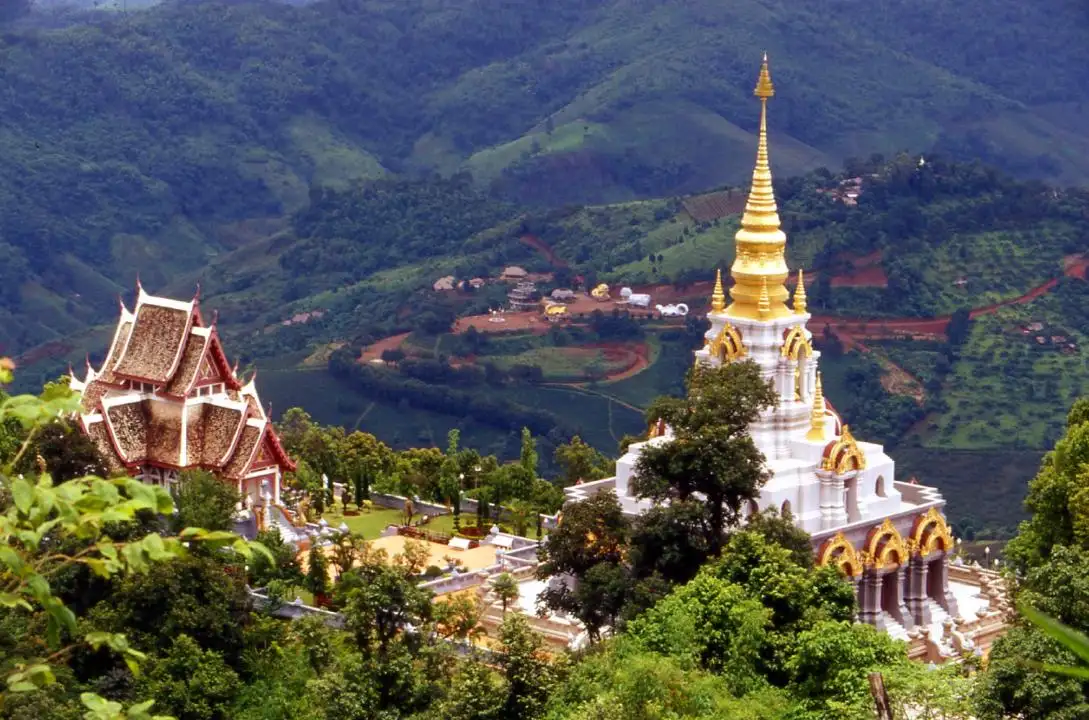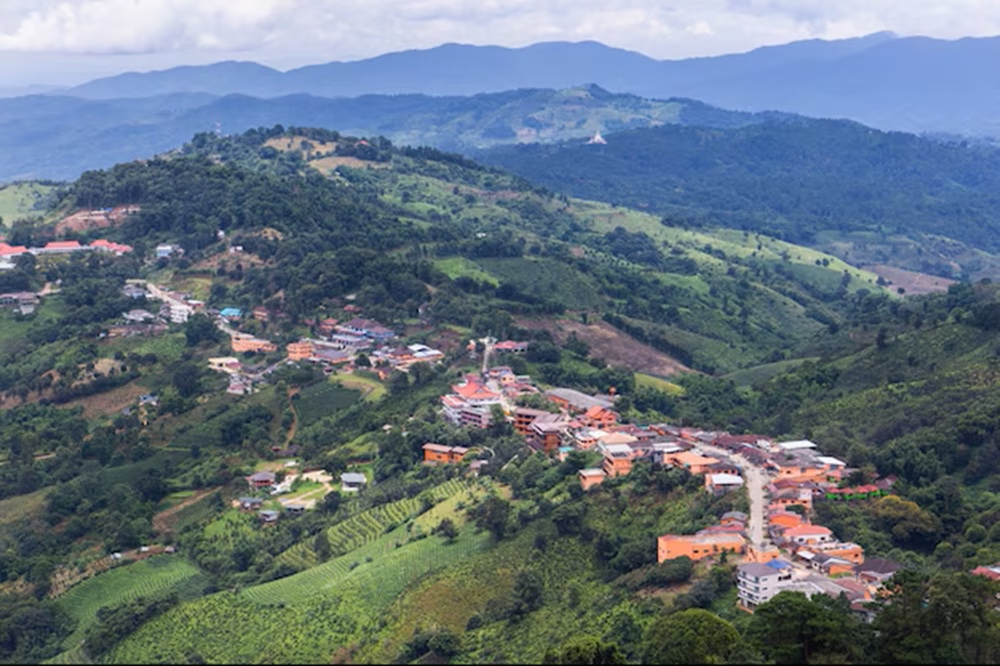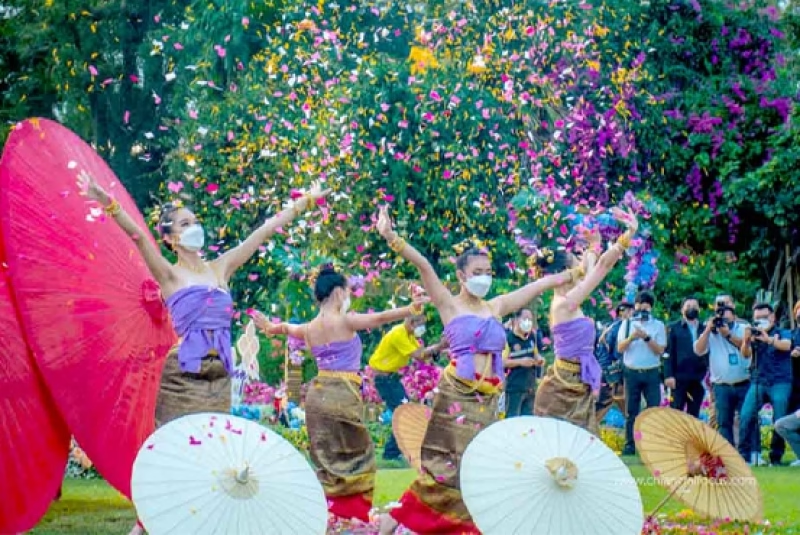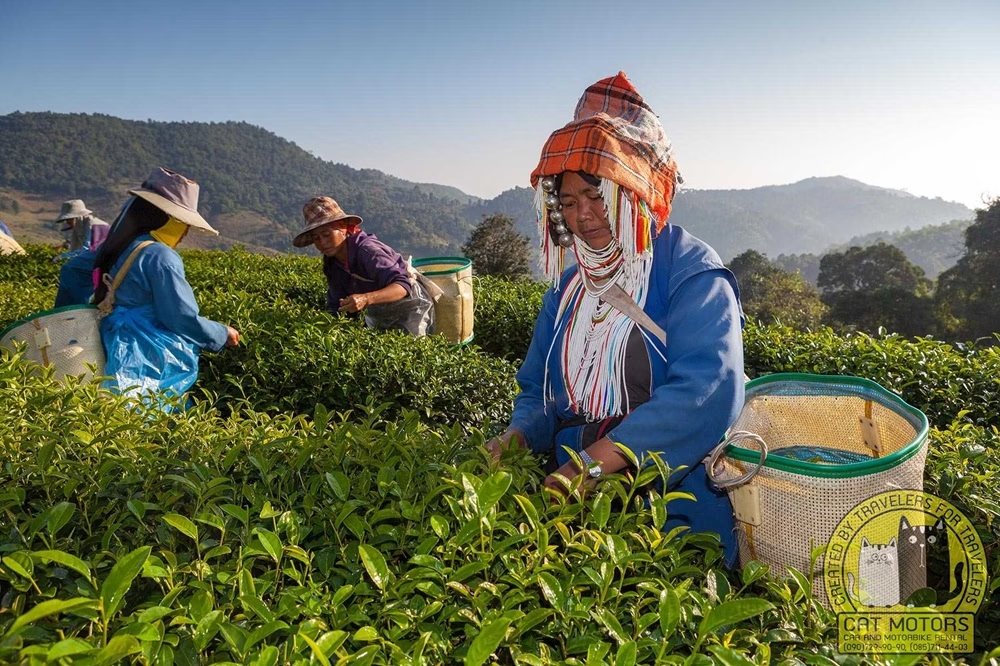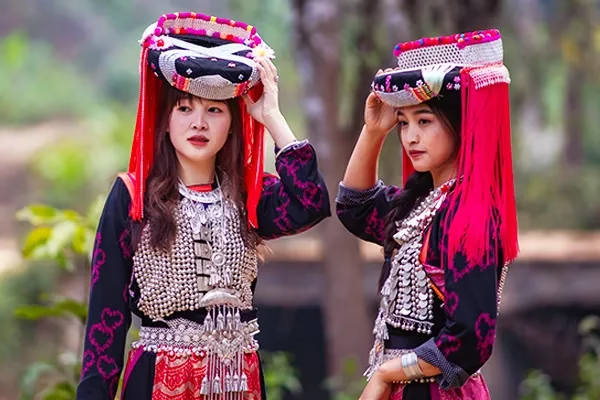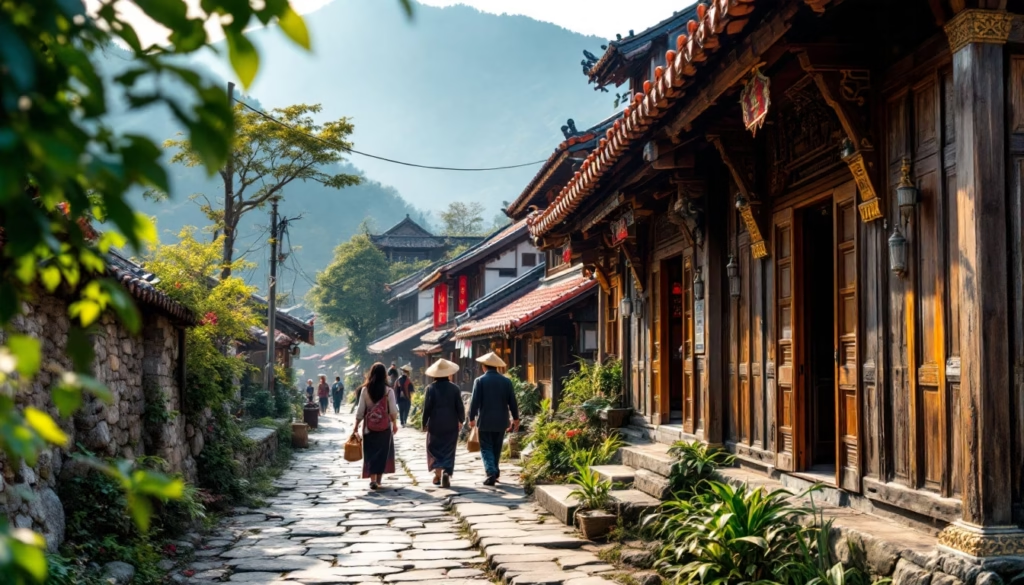CHIANG RAI – On the ridge of Doi Mae Salong, the scent of drying oolong drifts across terraced hills. Red lanterns line tight lanes, voices carry a Yunnan accent, and pots of pork knuckle simmer with star anise and soy. The village, officially Santikhiri, or Hill of Peace, feels a world away from Bangkok’s neon and Phuket’s beaches.
It is a living archive of the Yunnanese Chinese diaspora, a fragment of China set in the folds of the Golden Triangle. As Chiang Rai rises as a favourite for Chinese travellers, with more than 1.5 million visiting in the first nine months of 2025, Mae Salong is no longer a quiet outpost. It has become a touchstone for memory, nature, and shared history, and it speaks to visitors from across the Chinese mainland.
Thailand’s tourism revenue reached 1.98 trillion baht this year from 36 million international arrivals. Chinese visitors, expected to reach 9 million by year’s end, have powered the north’s revival. Many now look beyond Phuket’s coasts and Chiang Mai’s wats. They want real stories, the kind you taste in a cup of tea. Mae Salong offers exactly that.
The community has kept its Yunnanese language and customs with stubborn care, shaped by exile and reinvention. Soldiers retooled as tea farmers, poppy fields gave way to orchards and blossoms. For the growing number of Chinese sightseers, it feels like a homecoming without the long flight, a bridge between heritage and daily life in Thailand’s green hills.
Tongues of the Hills: Yunnanese Speech in a Thai Setting
In Mae Salong’s market, the language of trade and gossip is Mandarin with a Yunnan twist. It is not standard Putonghua, but a softer, lilting dialect from China’s southwest. Older residents haggle in dialect over fruit and greens. Children switch between Thai script and Chinese characters on their phones. This insistence on language keeps the community’s identity intact.
As new roads linked the village in the 1980s and visitors began to arrive, locals moved to protect their culture. The Mae Salong Chinese School, opened in 1965 with help from Taiwan, teaches Mandarin alongside the Thai programme.
Texts use traditional characters, a quiet nod to KMT roots as Beijing’s influence grows across the region. “Our language keeps us steady,” says Wang Xiu-lan, 45, a teacher whose pupils include Chin Haw families and children from nearby hill tribes. They recite Tang poetry with crisp tones. Enrolment has risen by about 30 percent since 2020, helped by interest from Chinese tour groups seeking short classes.
Change still seeps in. Younger people mix Yunnanese with Thai slang. Apps help Akha and Hmong neighbours join the conversation. Bilingual signs mark streets and squares. “Santi Khiri” in Thai sits beside “Mei Si Le” in Hanzi, a cheerful phrase that also reads as “all is well.”
For many Chinese travellers who do not speak Thai, it offers comfort and ease. “It was the first time I spoke freely abroad,” says Liu Fen, a retiree from Shanghai, sipping tea at a stall where vendors chat in dialect. The soundscape blends Yunnanese, Mandarin, Thai, and Akha, a reflection of the area’s mix of peoples and a draw for linguists and culture lovers.
Oral stories add depth. Families tell the “Long March South” at home altars during the Lunar New Year. Festivals repeat these tales with music and dance. The Cherry Blossom Festival, held from 28 December to 2 January, brings KMT-style parades and hill tribe performances, with captions in three languages. As one elder puts it, “Our words kept the past from slipping away.”
Faith, Festivals, and Family: Traditions in the Clouds
Mae Salong’s rituals cross borders. At daybreak, incense rises from Confucian shrines. Families offer rice wine and mooncakes to ancestors. The Dragon Mountain Temple, built in the 1970s, shows a blend of Taoism, Buddhism, and local beliefs. Monks chant alongside hill tribe shamans, a pattern that mirrors Yunnan’s religious mix.
Mid-Autumn in September turns the mountain into a lantern-lit scene. Strings of red silk sway over lanes, lion dances drum through the streets, and tables fill with pomelos and sweets. “It is not just a holiday, it is memory made visible,” says Chen Hao, 28, a performer whose troupe draws on KMT martial arts. Visitor numbers rise each year. In 2024, more than 5,000 Chinese tourists joined the event, according to local tourism notes.
Family ties remain at the core. Weddings pair Thai flower garlands with Chinese tea ceremonies. Funerals follow Hakka-style rites, with paper offerings burned for the next life. The Chin Haw Cultural Center preserves skills such as silk weaving and herbal practice, rooted in Yunnan traditions. “We share what we know so it does not fade,” says curator Somboon Lee.
From Poppies to Tea: Mae Salong’s Food Story
Mae Salong’s kitchen tells its history. Dishes are simple, hearty, and full of flavour. At Im Pochana, a fixture since the 1970s, clay pots carry noodles in rich bean gravy. Kha moo nam daeng, pork leg braised without sweetness, tastes of soy, cinnamon, and spice, served with soft mantou. “When bullets failed us, food kept us going,” jokes owner Ah Poch, serving moo nam khang, air-dried pork fried with chillies, a throwback to lean times.
The hill’s altitude and cool air, topping out around 1,367 metres, have shaped a tea economy. Mae Salong produces a large share of Chiang Rai’s tea, with around 200 tonnes of high-mountain oolong a year. Plantations such as Choui Fong spread in neat lines over rolling slopes. Tastings teach gongfu methods, with hot water poured over leaves in porcelain gaiwans. Chinese travellers spend on average 6,400 baht per day here. Of the 200,000 visitors to tea estates in 2025, about 40 percent come from the mainland, lifting sales by roughly 25 percent year on year.
A Muslim Yunnanese thread runs through the menu as well. Salima’s beef noodles bring cumin and slow-cooked broth to the table. Preservation skills, such as pickled greens and sun-dried meats, once born of hardship, now draw curious food lovers. As chef and researcher Pollavat Prapattpong wrote in 2021, “Doi Mae Salong’s flavours speak for tolerance.” Social feeds agree. #YunnanInThailand has clocked about half a million posts.
Wild Beauty and Living Culture
Nature frames the story. In December, cherry trees paint the hills in pink, and around 100,000 people arrive for parades, markets, and craft fairs. Stalls show Akha embroidery and Hmong silver work beside Chinese lanterns and calligraphy. Sunflowers brighten November, and plum trees ripen with the rains. Seasonal cycles fit with Yunnanese rites for the solstice and harvest.
Trails to Akha settlements show shared threads between animist beliefs and Yunnanese shamanic practice. “Borders soften up here,” says Kham, a local guide, as groups walk past signs from the era of the opium ban to ridgeline lookouts facing Myanmar’s mist and Thailand’s green valleys. Eco-tourism supports families. According to tambon reports in 2025, about 70 percent of local income comes from sustainable farms and related services.
Chiang Rai’s rise from quiet province to headline destination owes much to China. Before the pandemic, Thailand hosted about 11 million Chinese visitors per year. In 2024, arrivals reached around 8 million, about 90 percent of 2019 levels. Forecasts for 2025 aim at 9 million.
The north attracts roughly a fifth of that traffic. Chiang Rai’s White Temple and the Golden Triangle welcomed about 1.2 million between Q1 and Q3 2025, up 35 percent on 2024. Mae Salong has grown with that tide. TAT Chiang Rai records around 150,000 Chinese visitors so far this year, helped by film-driven travel and Weibo creators who style it as “Yunnan 2.0.”
Travel feels simpler and safer after border concerns in 2024. Direct flights now link Shanghai and Chiang Rai three times a week. Higher spenders choose wellness stays. Tea spa programmes fold in TCM techniques with Thai massage. Peak seasons hit around 75 percent occupancy.
Province-wide revenue stands at 1.58 billion baht. Pressure points remain. Busy roads and litter strain the hills. The government promotes “Half-Half Travel” subsidies to move crowds to off-peak and lesser-known spots, including nearby Nan. Locals adjust. Homestays like Little Home, at about 1,000 baht a night, teach dialect basics and share family meals.
For Zhang Mei, the pull is personal. “Chiang Rai is not escape, it is echo.” In Mae Salong, the echo turns into a chorus, a clear note of endurance and belonging.
Guarding What Matters: The Road Ahead
More buses now climb Highway 1089. With growth comes risk. Plastic waste appears on trails. Dry seasons bite into water stores. Villagers answer with their own plans, from zero-waste tea gardens to festival slots reserved for cultural groups. Support comes from outside as well. Taiwanese NGOs fund schools, even as island politics shift. Scholarships from China also appear, part of a wider push for influence.
Young people still move to Chiang Rai city for work and study. Traditions adjust. Apps document dialects. Local voices such as Wang Xiu-lan gather large followings on Douyin. “We are Thai-Chinese, both at once,” she says. With TAT’s Grand Tourism Year aiming for 40 million arrivals in 2025, Mae Salong sets itself up as a model for careful growth, with eco-lodges, heritage walks, and hands-on workshops.
From Chiang Rai’s clock tower, the 80-kilometre ride to Mae Salong passes fields of sunflowers and misty valleys. Hop on a songthaew, hire a scooter for about 300 baht per day, or book a tour for roughly 1,500 baht. Aim to arrive by midday. Start with tea at Rai Cha 101, then lunch on the terrace at Yang Ming. Hike to the viewpoints, browse hill tribe crafts, and leave with packets of oolong for home.
In this Yunnanese aerie, travellers find more than views. They find a community that kept its language, faith, and food alive against the odds. As dusk settles and lanterns glow, the sign feels right. Mei Si Le. All is well.




